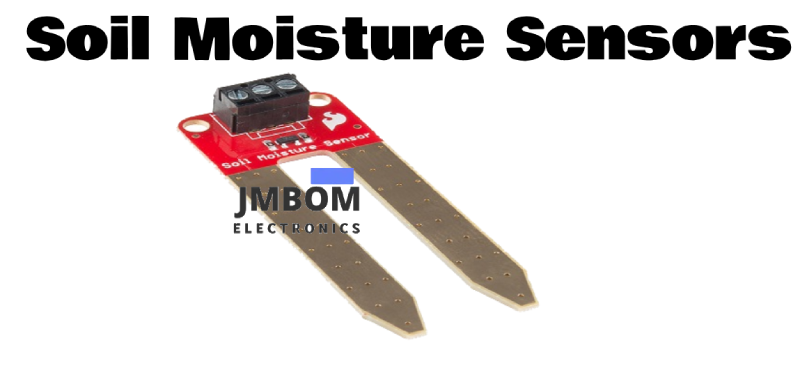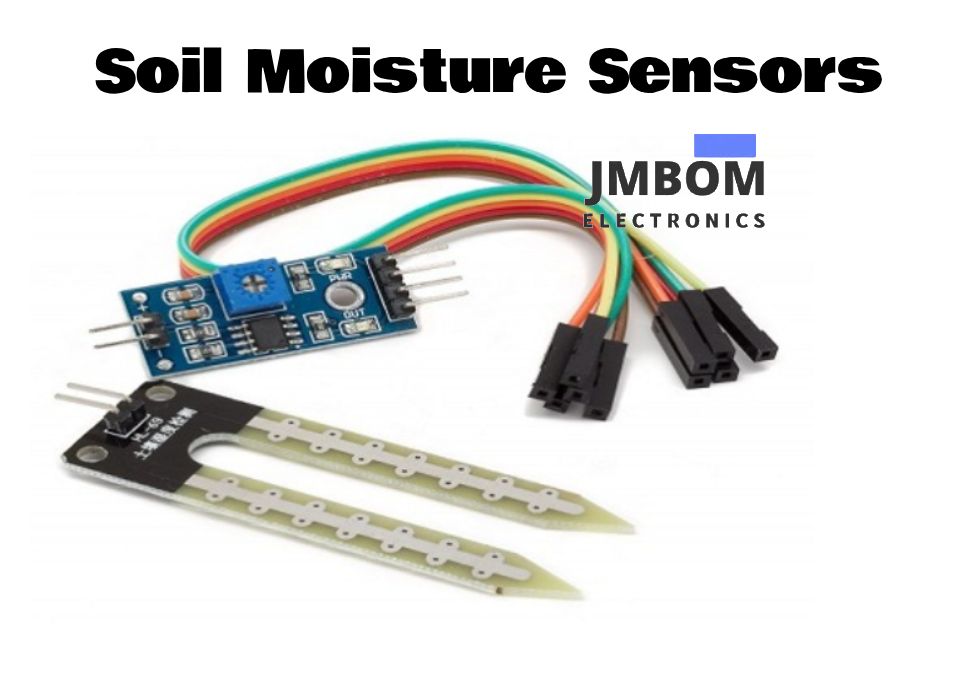

Soil Moisture Sensors: How They Work and Where They're Used
Catalog
What Is a Soil Moisture Sensor?Soil Moisture Sensor Pin ConfigurationWorking PrincipleSpecificationsApplications of Soil Moisture SensorsSensor Installation and PlacementFrequently Ask QuestionsRelated ArticlesSoil moisture plays a crucial role in agriculture and gardening. Just as soil nutrients are vital for plant growth, the right amount of water is essential for maintaining healthy plant temperature and promoting proper root development. Water helps regulate plant temperature through processes like transpiration, and moist soil encourages stronger root systems. However, too much moisture can create anaerobic conditions that not only affect plant growth but also promote harmful soil pathogens.
This article provides a clear overview of how soil moisture sensors function and explores their key applications in various fields.
What Is a Soil Moisture Sensor?
A soil moisture sensor is a device designed to measure the water content in soil. Unlike traditional gravimetric methods, which involve removing, drying, and weighing soil samples, these sensors estimate moisture levels indirectly. They do this by detecting changes in soil properties such as dielectric constant, electrical resistance, or through interactions with neutrons — all of which are influenced by the amount of water present.
The relationship between these measured properties and actual soil moisture must be calibrated and can vary depending on environmental factors like soil type, temperature, and electrical conductivity. In agriculture and hydrology, remote sensing techniques often rely on microwave signals, which are affected by soil moisture, to monitor conditions across large areas.
These sensors are commonly used to measure the volumetric water content in soil. However, there is another category of sensors designed to detect a different moisture-related property known as soil water potential. These are referred to as soil water potential sensors and typically include devices like gypsum blocks and tensiometers.

Soil Moisture Sensor Pin Configuration
The FC-28 soil moisture sensor features a 4-pin interface, making it easy to connect with microcontrollers or development boards for data monitoring and control.

The FC-28 soil moisture sensor module includes four pins, each serving a specific function:
- VCC – Supplies power to the module
- A0 (Analog Output) – Provides an analog signal that varies with soil moisture level
- D0 (Digital Output) – Outputs a digital HIGH/LOW signal based on the moisture threshold
- GND – Ground connection
The module is equipped with an adjustable potentiometer that sets the moisture threshold level. This threshold is compared with real-time moisture readings using an onboard LM393 comparator. An LED indicator will automatically turn ON or OFF based on whether the detected moisture is above or below the set threshold.
Working Principle
The soil moisture sensor primarily works on the principle of capacitance to measure the water content in soil, specifically by detecting changes in dielectric permittivity. To use the sensor, simply insert it into the soil—based on the moisture level, it provides an output indicating the percentage of water content.
This type of sensor is ideal for hands-on experiments and educational projects in subjects such as environmental science, agriculture, biology, soil science, botany, and horticulture.
Specifications
Key specifications of the soil moisture sensor:
- Operating Voltage: 5V
- Current Consumption: < 20mA
- Interface Type: Analog
- Operating Temperature Range: 10°C to 30°C
Applications of Soil Moisture Sensors
Soil moisture sensors are widely used in a variety of fields, including:
- Agriculture – For monitoring and managing irrigation efficiently
- Landscape Irrigation – To optimize water usage in parks, lawns, and gardens
- Scientific Research – In studies related to soil properties, climate impact, and crop performance
- Home Gardening – As simple tools for hobbyist gardeners to maintain healthy plant growth
Sensor Installation and Placement
To accurately measure soil moisture across a field, sensors should be installed at various depths and multiple locations. A common practice is to place sensors in pairs at one-third and two-thirds of the crop root zone depth, and at two or more representative spots in the field. It’s best to avoid placing sensors near high spots, low areas, or slopes, and instead choose uniform soil zones for reliable data.
In fields that contain both heavy (clay) and light (sandy) textured soils, it’s recommended to monitor each soil type separately for more precise irrigation management. Tools like electromagnetic conductivity (EM) mapping can help identify different soil zones based on their water-holding capacity. These zones can then be managed independently, improving irrigation efficiency and crop health.
Where to Place Soil Moisture Sensors
- Place sensors between plants within a crop row, at the desired measurement depths.
- Mark or flag the installation sites so field equipment operators can avoid damaging them.
- Avoid placing sensors near pivot wheel tracks, which can skew readings.
- Ensure the sensor is in direct contact with undisturbed soil for accurate results.
How to Install Soil Moisture Sensors
The installation method depends on the sensor type, so always refer to the manufacturer’s instructions. In general, sensors are installed in one of two ways:
- Trench Method: Dig a small trench and insert sensors horizontally at different depths.
- Auger or Probe Method: Use a soil auger or sampling probe to bore holes and install sensors vertically.
Important tips:
- Avoid oversized holes — they can create air gaps around the sensor, leading to inaccurate readings.
- If necessary, some installers use a soil-water slurry to fill gaps, but this can alter the soil structure around the sensor and affect performance. It's usually better to minimize soil disturbance during installation to preserve the soil's natural conditions.
In summary, soil moisture sensors are designed to measure the volumetric water content of soil, making them valuable in both practical applications and educational experiments. They are commonly used in disciplines such as agricultural science, soil science, horticulture, environmental science, biology, and botany.
Frequently Ask Questions
How Does a Soil Moisture Sensor Work?
Soil moisture sensors measure or estimate the water content in the soil. These devices come in stationary and portable forms.
- Stationary sensors are permanently installed at specific locations and depths in a field to provide continuous monitoring.
- Portable sensors (like handheld probes) can be moved between locations to take spot readings in different parts of the field or garden.
What Are Common Problems with Soil Moisture Sensors?
One of the main issues is water accumulation inside the sensor, especially since it operates in a damp environment. Over time, moisture can seep into the sensor housing, leading to inaccurate readings, corrosion, or reduced sensor lifespan.
What’s the Difference Between a Soil Moisture Sensor and a Rain Sensor?
- A soil moisture sensor detects how much water is present in the soil. It helps ensure plants receive the correct amount of water.
- A rain sensor measures rainfall — it detects when rain occurs and how much water has fallen on a surface.
What Is the Life Expectancy of a Soil Moisture Sensor?
Typically, soil moisture sensors last between 3 to 5 years. With proper installation and maintenance, higher-quality models can last even longer, often over 5 years.
How Can I Make a Simple Soil Moisture Sensor at Home?
You can build a basic DIY sensor using household items:
- Take two metal nails and push them through a plastic bottle cap, spaced 1 inch apart.
- Use hot glue to secure them in place.
- Solder a wire to each nail.
- Seal the cap with hot glue for durability.
- Insert the sensor into the soil and connect it to a basic electronic circuit to monitor moisture changes.
How Do I Know if My Soil Moisture Sensor Is Faulty?
Signs your sensor may be malfunctioning:
- Constantly reads "dry" even in moist soil
- Shows no change in values between dry and wet conditions
- Has corrosion or physical damage on the probes
- You can test the sensor using a multimeter or by comparing values from dry and wet soil
How to Test if a Soil Moisture Sensor Is Working Properly?
- Insert the sensor into dry soil. The blue LED should light up, and the Serial Monitor (if connected to a microcontroller) should show readings below 600.
- Insert it into wet soil. The yellow LED should activate, and values should be above 600. This indicates the sensor is functioning correctly.
Why Does My Soil Moisture Meter Always Show “Dry”?
If your sensor always reads "dry," it could be due to:
- Incorrect placement — avoid putting the probe too close to the edge of the pot.
- Not inserted deep enough — place the probe about three-quarters of the way down, between the plant stem and the edge, near the root zone where moisture is most concentrated.
Related Articles
Capacitive Sensors : How They Work and Where They’re Used
How Voltage Sensors Work and Their Common Applications
How Do Distance Sensors Work and Where Are They Used?
Throttle Position Sensors: How They Work and Where They're Used
How Inductive Sensors Work and Where They're Used
How a Flame Sensor Works and Where It's Used
Subscribe to JMBom Electronics !













